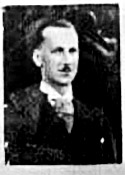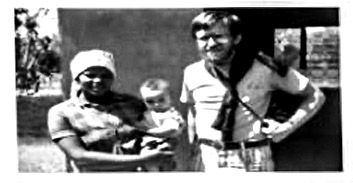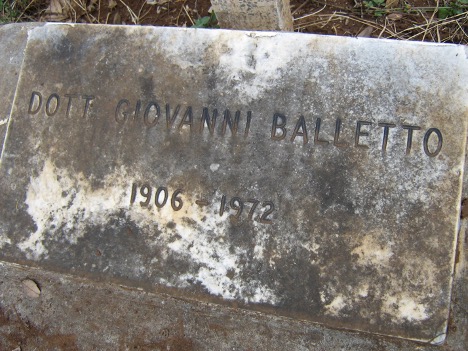“Remembering Doctor Giovanni Balletto” by George Brose (Tanzania)
On November 18, 2022 John Coyne wrote an entry on this site talking about the “give away books” at his public library. I was inspired to follow up with this piece.
Remembering Giovanni Balletto
by George Brose Tanzania (1966-67)
John:
I, too, forage for books on the give away rack in our library where I live now in Comox, British Columbia. Recently my Peace Corps experience came into play with those free books. But, to see the connection, you will have to be patient and let me tell the lead in to acquiring a free book at my library.

Giovanni Balletto in Medical School
In the Peace Corps, in 1966-67, I was stationed in Moshi, Tanzania at the base of Mt. Kilimanjaro, and I often climbed the mountain with an aging Italian doctor, Giovanni Balletto. Dr. Balletto ran a small health clinic on the Marangu Road that led up to where most of the climbing expeditions started in those days.
During WWII, he, along with many Italian civilians living in Ethiopia, had been interned in concentration camps around the British colonies in Africa. His camp was at the base of Mt. Kenya in the town of Nanyuki.
During his almost six-year imprisonment, Giovanni and two other inmates dreamed of freedom and climbing mountains. They spent months preparing an escape from the camp to climb Mt. Kenya. They had no route map of the mountain. The only map they had was from a tin of beans that had a picture of Mt. Kenya in its logo.
They cold forged an old hammer into an ice axe. From a running board on a car, they fashioned crampons to walk more safely on ice. Climbing ropes were woven from the netting from the bed frames that they slept on. They hoarded food, and fabricated rucksacks. I’m not sure what they did for warm clothing. But when all was ready, they escaped and went on the mountain for 17 days. Unable to reach the main peak they managed to climb a secondary peak, Point Lenana, on the mountain, and placed an Italian flag there. Then not having anywhere to go, they broke back into the camp and turned themselves in to the camp commandant.
When the story got back to Rome, they became war heroes. As punishment they were sent to another camp where all the hard-core fascists were being held, but Giovanni said the food was better there, because the fascists were screaming about their rights under the Geneva Convention, so the British were treating everyone somewhat better.
After the war, Giovanni remained in Africa and settled in Tanganyika. Years later one of the two other climbers, Felice Bennuzi, wrote a book about the adventure, No Picnic on Mt. Kenya: The Story of Three POWs’ Escape to Adventure which became a popular boys’ book in the Commonwealth, and was an inspiration for the creation of the Outward Bound Schools. Though heavily fictionalized, the story was made into a film The Ascent starring Ben Cross of Chariots of Fire fame.
During my time in Tanzania our friendship developed. He took me climbing and literally showed me the ropes. Dr. Balletto was very old school, so I didn’t learn much of the modern technical techniques. He said, “If you can’t get up a pitch with more than a piton, a rope and a carabiner, you shouldn’t be climbing on it.” He showed me how to do an abseil* on a rope without any hardware. There’s a saying that you have to have leather balls to play rugby, the same goes for that kind of abseil.
After I finished my term in the Peace Corps we continued to write, and I even sent an army buddy down to Tanzania who wanted to climb Kilimanjaro, and introduced him to Dr. Balletto.
A few months later I received news that Dr. Balletto had committed suicide. I knew he had suffered from depression for years after his wife had left him, but I didn’t know the depths to where it had taken him. I later learned that he had fathered a child with a local woman, and when he went to the bishop to get permission to marry, he was refused, because his first wife had not divorced him. In those days there was no way around canonic law.
 In 1972 I had returned to Moshi on a search mission to find a lost climber on the mountain and took the opportunity to visit the mother of Giovanni’s child and little Giovanni. She was kind enough to give me some of his photographic collection. Left is a picture of the three of us.
In 1972 I had returned to Moshi on a search mission to find a lost climber on the mountain and took the opportunity to visit the mother of Giovanni’s child and little Giovanni. She was kind enough to give me some of his photographic collection. Left is a picture of the three of us.
In 2007, I had the opportunity to return to the Kilimanjaro area and decided I would visit Giovanni’s gravesite. I was writing a small travel blog for my family and friends.
Here is my entry from that blog:
Sitting at Dr. Balletto’s Grave
I walked out at 10 a.m. this morning after doing some errands in town, bus ticket to Dar, Swahili dictionary, library, etc. I had come out part way last night by taxi, but didn’t go far enough and so did not make it to the graveyard. This time when I asked directions my version of ‘cemetery’ which was slightly different from the local word ‘makbunini‘ is ‘makburini‘.
There were some gravediggers hard at work near the entrance and I asked them how well they knew the ‘makburini’, and one right away knew where Dr. Balletto’s grave was located. People seem to be buried chronologically, because there are few if any family plots. No wazungu (European) families are very prominent here. The grave had a white terrazzo roman cross and stone plaque: Dott Giovanni Balletto 1906-1972. He was 66 when he died. I knew him when he was 60 and I was 23. He seemed much older than that to me. There is a rectangular planter over the grave. The dirt in the center allows for planting of flowers. I cleaned out weeds as best I could, but left undisturbed some straw flowers that come from the alpine zone of the mountain that some caring person must have planted. This man was important to me. He showed me patience and caring. He had lived a good adventure, but he was human with his depression. He seems to have found a way out of it with his lover and child, but the rules of Rome did not allow a marriage of this sort.
I wrote a note to his son, Giovanni and put it in a plastic box.
To Young Giovanni
If you visit your father’s grave, someday, you may find this note. I was 23 when I met your father in 1966. He taught me many things about climbing, and about Kilimanjaro, and about his native land. He was a good man and good for Africa. I hope that you understand his greatness and that you can accept his choosing to leave you before he could teach you the things he taught to me when he was a happy man. George Brose
After writing the note to Giovanni, I walked through the cemetery some more and found the WW I graves of 88 Soldiers almost all from the South African Infantry. Black soldiers were buried with the whites. March 19 and 21, 1916 were particularly bad days for them as most of the deaths came on those two days. It was probably at the battle for Tanga on the coast. Why they were buried here (100 miles distant) is anybody’s guess. I will have to confirm those dates.
From those three paragraphs, I received a number of queries about what I had written. One of the inquisitors was an Italian writer who publishes books in consortium with two other writers. Their nom de plume is Wu Ming. I never saw one of their books until a few days ago in the free rack at the library and grabbed it. The title . . . Altai. Takes place in 16th century Venice and Istanbul. It is a wonderful story of the politics of the Eastern Mediterranean in those days, clash and cooperation of faiths, the intrigues, the changing of sides to survive for the Sephardim recently expelled from Spain, the influence of all these faiths and cultures that is no less complex today.
Wu Ming was interested in the Mt. Kenya adventure and asked for any details I could provide. I also received a request for similar material from the former Australian ambassador to Italy. He too was researching the story. But the most interesting letter came from an Argentinian law student who confided that Giovanni had been his grandmother’s lover in Italy in the 1930s, and that they had climbed together in the Dolomites. He sent along pictures as proof. He related that his grandmother had told him many tales of climbing in Italy. She was still alive, but now senility had set in and she could no longer tell the stories. In gratitude I sent him a Spanish translation of No Picnic in Kenya.
And so that is my story of how the free books at the library have brought me full circle back to my days in the Peace Corps. Thank. you, John.
•
George Brose (Tanzania 1966-67) attended the University of Oklahoma from 1961-1965, and was the team track captain in 1964 and 1965. His best Big 8 conference finish was 3rd indoors in the 1000 yards event. In 1965 he coached the Northern Tanzania track team at the national championships and qualified for the Tanzanian National 880 yard finals. George has completed 8 marathons with a best of 2:36. More recently, George was the head womenʼs cross country coach for the University of Dayton for five seasons retiring after the 2003 season.
*abseil – descend a rock face or other near-vertical surface by using a doubled rope coiled round the body and fixed at a higher point; rappel



Thanks John for sharing this feel good story! Helped boost my spirits after some challenging days. I’m fine just feeling my age
Wonderful story George and John,
When I was in the PC in Debre Marcos, Ethiopia, 1962-65. This was in Gojam province, 200 miles south of Bahr Dahr (Lake Tana) where the Blue Nile essentially surfaces. Dr. Mazelle (s), a vetenarian, left over from the Italian invasion of 1936 was the only, “Doctor,” for the two million people in the province. He was in our home for dinner one night. I went to him when I sprained my ankle pole vaulting, when I was coaching the high school track team. He treated it with Anlegesicc(sp) balm. He had stayed on as he cared for two local women.
Ours was the only high school in the province, so we had track meets with the faculty, police, and the army to get ready financially and athletically for the Empire Games in Addis Ababa.
Thanks again,
John Collins
John, your comment is an interesting story. How heavily were you involved in track and field in Ethiopia and back home? I was a track guy too. Ran at U. of Oklahoma, coached a bit in Tanzania. You were there when Abebe Bikila the big hero of the 60 and 64 olympics. I write a track and field history blog and have had several stories about the Ethiopians.
Having plantar fascitis once and no luck with treatments (in US) I consulted with a friend who was a veterenarian and runner. He suggested an anti inflammatory he used on dogs. I tried it and it worked very well, but I had to stop and pee at every fire hydrant I ran by. George Brose
I also share John Collins’ recollection of Dr. Marzelle in Debre Marcos, Ethiopia, in the early 1960’s when we were all Peace Corps Volunteers teaching at the only high school in all of Gojam province. I have no recollection that in fact Dr. Marzelle was a veterinarian. But when there is no other doctor for hundreds of kilometers, you don’t ask to see medical certificates. Many in Debre Marcos were grateful for his services. I don’t think I was ever treated by him, but I did take students to see him and recall that he was a gentle man who took careful care of his patients.
Many thanks for George’s soulful remembrance of his Dr. Balleto. I wish we had gotten to know our Dr. Marzelle better and heard his story.
Barry Hillenbrand
Ethiopia 1963-1965
Any suggestions on where or how to purchase the book by George Brose? Please email me at lurie@berkeley.edu
Thank you
Sorry, Joe,
Never wrote a book, just a few short pieces like this.
I do co-write a blog on history of track and field called Once Upon a Time in the Vest. Just google the title.
George
Grazie del racconto Mi ha chiarito molte cose. sono la nipote di Giovanni Balletto ho 446 anni vivo in Italia sono la figlia di Angela Balletto la più piccola dei tre figli che ha avuto Giovanni dal primo matrimonio.
Un abbraccio Luisa Anibaldi
Scusate sono sempre io Luisa Anibaldi ho sbagliato l’età Ovviamente ho 46 anni vivo in Italia e un abbraccio forte Luisa